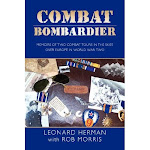 The Twenty-Ninth Infantry goes ashore on D-Day. Frank was there. He tells about it in his book.
The Twenty-Ninth Infantry goes ashore on D-Day. Frank was there. He tells about it in his book. One of my most prized possessions, a signed, First Edition of Etched in Purple, published back in 1949 by Caxton Printers, Caldwell, Idaho. Frank sent me the pristine dust jacket, over fifty years old.
One of my most prized possessions, a signed, First Edition of Etched in Purple, published back in 1949 by Caxton Printers, Caldwell, Idaho. Frank sent me the pristine dust jacket, over fifty years old. The new edition of Etched in Purple. If I could write one book as good as this, I could die a happy man.
The new edition of Etched in Purple. If I could write one book as good as this, I could die a happy man.The book I consider to be the greatest memoir of World War Two was released yesterday by Potomac Books. Frank Irgang wrote Etched in Purple shortly after returning from his hellish tour of duty as a medic, and, after attrition killed many of his comrades, regular infantryman in the famed 29th Infantry Division. Frank landed on the Normandy beachhead on D-Day and fougth his way through Europe, through the Battle of the Bulge, before being wounded.
What makes Frank's book so special is that he pulls no punches in relating what happened, from D-Day onwards. One of the most disturbing scenes in the book involves a German woman pouring boiling water on a wounded American soldier, as Frank watches. What would you do?
Frank has become a good friend over the years. I have no qualms admitting that my friend is also one of my heroes and mentors. His book is better than anything I could ever attempt to write. It is, in my opinion and that of Potomac Books, a 're-discovered classic'.
Don't pass this book up. It will change you forever. Frank tells it like it was, and believe me, he also proves that, in the words of General Sherman, 'War is Hell'
Who were the 29th Division? Here are some facts from the net:
Some stats and history on the 29th Division

The 29th Division was reactivated on 3 February 1941 and departed for the United Kingdom on 5 October 1942 where it continued training in Scotland and England from October of 1942 up to June 1944 in preparation for the invasion of France.
Teamed with the U.S. 1st Infantry Division, the 116th Infantry Regiment of the 29th Division was in the first assault wave to hit the beaches at Normandy on D-Day, 6 June 1944. The division itself landed on Omaha Beach on the same day in the face of intense enemy fire but soon secured the bluff tops and went on to occupy Isigny on 9 June. The division cut across the Elle River and advanced slowly toward St. Lo, fighting bitterly in the Normandy bocage (hedge rows).
After taking St. Lo on 18 July, the division joined in the battle for Vire, capturing that strongly held city on 7 August. Turning west, the 29th took part in the assault on Brest from 25 August to 18 September.
After a short rest, the division moved to defensive positions along the Teveren-Geilenkirchen line in Germany and maintained those positions through October. (In mid-October the 116th Infantry took part in the fighting at the Aachen Gap.) On 16 November the division began its drive to the Ruhr, blasting its way through Siersdorf, Setterich, Duerboslar, and Bettendorf, reaching the Ruhr by the end of the month.
On 8 December, heavy fighting reduced Juelich Sportplatz and the Hasenfeld Gut. From 8 December 1944 to 23 February 1945, the division held defensive positions along the Ruhr and prepared for the offensive. The attack jumped off across the Ruhr on 23 February and carried the division through Juelich, Broich, Immerath, and Titz to Mönchengladbach on 1 March. The division was out of combat in March, however in early April the 116th Infantry helped mop up in the Ruhr area and on 19 April the division pushed to the Elbe River and held defensive positions until 4 May. Meanwhile, the 175th Infantry Regiment cleared the Kloetze Forest. After VE Day, the division was on military government duty in the Bremen enclave.
The 29th Infantry Division had spent 242 days in combat during campaigns in Normandy, Northern France, the Rhineland and Central Europe, earning four Distinguished Unit Citations in the process. Two soldiers of the division were awarded the Medal of Honor. Also awarded were 44 DSCs, one DSM, 854 Silver Stars, 17 Legion of Merit, 24 Soldier's Medal and 6,308 Bronze Stars.
Teamed with the U.S. 1st Infantry Division, the 116th Infantry Regiment of the 29th Division was in the first assault wave to hit the beaches at Normandy on D-Day, 6 June 1944. The division itself landed on Omaha Beach on the same day in the face of intense enemy fire but soon secured the bluff tops and went on to occupy Isigny on 9 June. The division cut across the Elle River and advanced slowly toward St. Lo, fighting bitterly in the Normandy bocage (hedge rows).
After taking St. Lo on 18 July, the division joined in the battle for Vire, capturing that strongly held city on 7 August. Turning west, the 29th took part in the assault on Brest from 25 August to 18 September.
After a short rest, the division moved to defensive positions along the Teveren-Geilenkirchen line in Germany and maintained those positions through October. (In mid-October the 116th Infantry took part in the fighting at the Aachen Gap.) On 16 November the division began its drive to the Ruhr, blasting its way through Siersdorf, Setterich, Duerboslar, and Bettendorf, reaching the Ruhr by the end of the month.
On 8 December, heavy fighting reduced Juelich Sportplatz and the Hasenfeld Gut. From 8 December 1944 to 23 February 1945, the division held defensive positions along the Ruhr and prepared for the offensive. The attack jumped off across the Ruhr on 23 February and carried the division through Juelich, Broich, Immerath, and Titz to Mönchengladbach on 1 March. The division was out of combat in March, however in early April the 116th Infantry helped mop up in the Ruhr area and on 19 April the division pushed to the Elbe River and held defensive positions until 4 May. Meanwhile, the 175th Infantry Regiment cleared the Kloetze Forest. After VE Day, the division was on military government duty in the Bremen enclave.
The 29th Infantry Division had spent 242 days in combat during campaigns in Normandy, Northern France, the Rhineland and Central Europe, earning four Distinguished Unit Citations in the process. Two soldiers of the division were awarded the Medal of Honor. Also awarded were 44 DSCs, one DSM, 854 Silver Stars, 17 Legion of Merit, 24 Soldier's Medal and 6,308 Bronze Stars.
The 29th in Popular Culture
In the 1962 film The Longest Day much of the action of the 29th on Omaha Beach on D-Day is depicted, with assistant division commander Brigadier General Norman Cota portrayed by Robert Mitchum.
Close Combat, part of a Microsoft Series of wargames during the 1990s also portrayed the actions of the 29th Division from Omaha Beach to the capture of St. Lo.
In the 1962 film The Longest Day much of the action of the 29th on Omaha Beach on D-Day is depicted, with assistant division commander Brigadier General Norman Cota portrayed by Robert Mitchum.
Close Combat, part of a Microsoft Series of wargames during the 1990s also portrayed the actions of the 29th Division from Omaha Beach to the capture of St. Lo.
In the 1998 film "Saving Private Ryan", many of the soldiers seen in the Omaha Beach sequence are from the 29th, identified by their shoulder insignias. Corporal Timothy E.Upham, for instance, is portrayed as a soldier serving with the 29th Infantry Division. Upham was drafted to serve with a squad from the 2nd Rangers. The 29th, along with the 1st Infantry Division, were grouped with a few companies of the 2nd Ranger Battalion to storm Omaha Beach on June 6th, 1944.
Order the book from Potomac here: http://www.potomacbooksinc.com/Books/BookDetail.aspx?productID=180789
Order the book from Amazon here: http://www.amazon.com/Etched-Purple-One-Soldiers-Europe/dp/1597972045/ref=pd_bbs_sr_1?ie=UTF8&s=books&qid=1205633371&sr=8-1







No comments:
Post a Comment